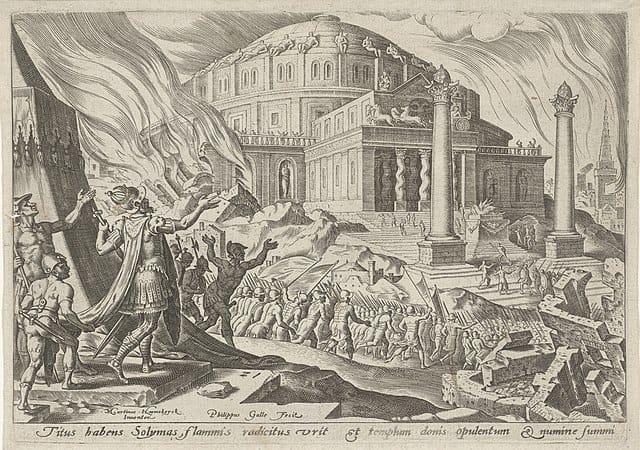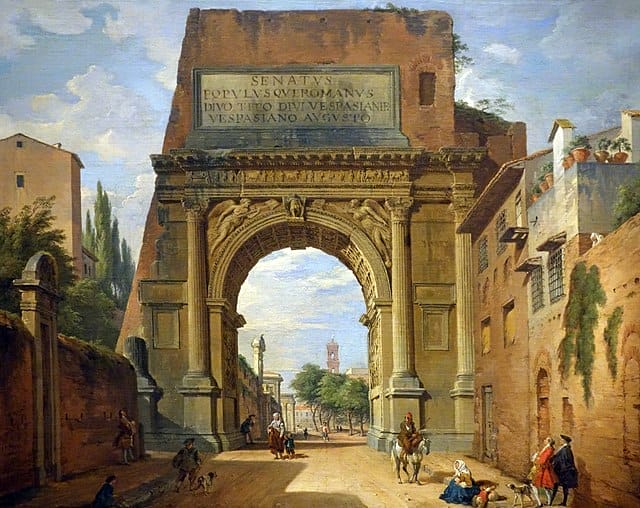Last Updated on October 24, 2023 by Vladimir Vulic
Life: AD 40 – 81

- Name: Titus Flavius Sabinus Vespasianus
- Born on 30 December AD 40 in Rome
- Son of Vespasian and Flavia Domitilla.
- Legionary commander and then commander-in-chief in Palestine.
- Became associate emperor in AD 71
- Emperor in AD 79.
- Married (1) Arrecina Tertulla; (2) Marcia Furnilla (one daughter, Flavia Julia).
- Died on 13 September AD 81. Deified in AD 81.
Early Life of Titus
Titus, the elder son of emperor Vespasian, was born in AD 39. He was educated together with Claudius’ son Britannicus, who became a close friend of his.
From AD 61 to 63, he served in Germany and Britain as a military tribune. After this, he returned to Rome and married Arrecina Tertulla, the daughter of a former commander of the praetorian guard. But only a year later, Arrecina died, and Titus married yet again, this time Marcia Furnilla. She was of a distinguished family, which had connections to opponents of Nero. After the failure of the Pisonian conspiracy, Titus saw it best not to be connected in any way with any potential plotters and, hence, divorced Marcia in AD 65. In the same year, he was appointed quaestor and became commander of one of his father’s three legions in Judaea in AD 67 (XV Legion ‘Apollinaris’).
In late AD 68, Titus was sent by Vespasian as a messenger to confirm his father’s recognition of Galba as emperor. But at reaching Corinth, he learned that Galba was already dead and turned back. Titus played a leading role in the negotiations, which led to his father being proclaimed emperor by the eastern provinces. It was, in fact, Titus who was credited with having reconciled Vespasian with Mucianus, the governor of Syria, who became his principal supporter.
Young Nero?
As a young man, Titus was dangerously like Nero in his charm, intellect, ruthlessness, extravagance, and sexual desires. Gifted physically and intellectually, exceptionally strong, short with pot-belly, with an authoritative yet friendly manner, and a supposedly excellent memory, he was an excellent rider and warrior. He could also sing, play the harp, and compose music. His reign was short, but he lived long enough to demonstrate that he had, obviously thanks to the guidance of his father, some talent for government, but not long enough for any judgment to be made as to how effective a ruler he would have been.
In the summer of AD 69, Vespasian set out for Rome to claim the throne, leaving him in charge of the military operation against the Jews in Judaea. In AD 70, Jerusalem fell to his troops. Titus’ treatment of the vanquished Jews was infamously brutal. His most notorious act was to have the Great Temple of Jerusalem destroyed (its only remainder today, the only piece of the temple to survive Titus’ wrath, is the famous ‘Wailing Wall’ – the most holy place to followers of the Jewish faith).

Titus’ success won him much praise and respect in Rome and among the legions. The massive arch of Titus, celebrating his triumph over the Jews, still stands in Rome. His triumphalism after his victory over the Jews raised suspicions that he might become disloyal to his father. But his loyalty to his father didn’t wain. He knew himself Vespasian’s heir, and was sensible enough to wait until his time would come. And he could count on his father to pass on the throne to him, for Vespasian is reported to have once said, ‘Either my son shall be my successor or no one at all.’

Titus’s Rise to the Power
Already in AD 70, while still in the east, Titus was made joint consul with his father. Then, in AD 71, he was granted tribunician powers, and in AD 73, he shared the censorship with his father. So, too did he become praetorian prefect. This was all part of Vespasian’s grooming of his son as successor.
Throughout this time, Titus was his father’s right-hand man, conducting routine affairs of state, dictating letters, and even delivering his father’s speeches in the senate. Though so too did he do his father’s dirty work in his position of praetorian prefect, removing political opponents by questionable means. It was a role which made him deeply unpopular with the people.
A serious threat to his succession was his affair with the Jewish princess Berenice, ten years his senior, beautiful, and with powerful connections in Rome. She was the daughter (or sister) of the Jewish king, Herod Agrippa II, and Titus called her to Rome in AD 75. As he had divorced his second wife, Marcia Furnilla, in AD 65, Titus was free to remarry. And for a while, Berenice lived openly with Titus in the palace. But the pressure of public opinion, mixed with wild anti-Semitism and xenophobia, forced them apart. There was even talk of her being a ‘new Cleopatra’. Rome was not prepared to tolerate an Eastern woman close to power, and Berenice had to return home.
When, in AD 79, a plot against Vespasian’s life was revealed to him, Titus acted swiftly and ruthlessly. The two leading conspirators were Eprius Marcellus and Caecina Alienus. Caecina was invited to dine with Titus, only to be stabbed to death on arrival. Marcellus was later sentenced to death by the senate and killed himself.
Disliked by the People and the Senate
Later, in AD 79, Vespasian died, and on 24 June, Titus succeeded to the throne. At first, he was deeply unpopular. The senate disliked him for having no part in his appointment and for having been the ruthless figure for the less savory matters of state in Vespasian’s government. Meanwhile, the people disliked him for continuing his father’s unpopular economic policies and taxes.
His dalliance with Berenice had also not won him any favor. In fact, many feared him to be a new Nero. It was, therefore, that Titus now embarked on creating a kinder image of himself with the people of Rome. The network of informers, on which emperors heavily relied but which created an air of suspicion throughout society, was drastically reduced in size.
The Eruption of the Mount Vesuvius
The charge of high treason was abolished. More surprisingly, two new suspected conspirators were simply ignored. And when Berenice returned to Rome, she was sent back to Judaea by a reluctant emperor. Only one month after Titus’ accession, though, a disaster should strike, which should overshadow his reign. The eruption of the Mount Vesuvius volcano overwhelmed the towns of Pompeii, Herculaneum, Stabiae, and Oplontis.
There is a surviving eye-witness account by Pliny the Younger (61-c.113), who was staying at Misenum at the time:
‘To us at a distance, it was not clear which mountain was belching out the cloud, but it was later discovered to be Vesuvius. In form and shape, the column of smoke was like a tremendous pine tree, for at the top of its great height, it branched out into several skeins. I assume that a sudden burst of wind had carried it upwards and then dropped, leaving it motionless and that its own weight then spread it outwards. It was sometimes white, sometimes heavy and mottled, as it would be if it had lifted up amounts of earth and ashes.’

Within an hour or so, Pompeii and Herculaneum, among several other towns and villages in the area, were engulfed by lava and red-hot ash. Many managed to escape with the help of the fleet stationed at Misenum. Titus visited the stricken area, announced a state of emergency, set up a relief fund into which was put any property of victims who died with no heirs, offered practical assistance in rehousing survivors, and organized a senatorial commission to provide whatever help it could. Yet this disaster should tarnish Titus’ memory until this day, many describing the outbreak of the volcano as divine punishment for the destruction of the Great Temple in Jerusalem.
But Titus’ troubles were not over with the Vesuvian disaster. While he was still in Campania in AD 80, overseeing the operations to aid the victims of the volcano, a fire ravaged Rome for three days and nights. Once more, the emperor provided generous relief to the victims.
But yet another catastrophe should blight Titus’ reign, as one of the worst epidemics of plague on record befell the people. The emperor tried his utmost to combat the disease, not only with medical support but also with extensive sacrifices to the gods.
From a Villain to a Hero
Titus, though, is not only famed for disaster but for the opening of the Flavian Amphitheatre, better known under the name ‘Colosseum’ as well. Titus finished the building work which had been begun under his father and inaugurated it with a series of lavish games and spectacles.
On the last day of the games, though, he is said to have broken down and wept in public. His health had taken a marked downturn by then, and perhaps Titus knew himself suffering from an incurable disease. Titus also had no direct heir, which meant his brother Domitian would succeed him. And Titus is said to have suspected that this would lead to disaster.
For all the accidents and disasters that befell his short reign – and considering how disliked he was at the outset, Titus became one of Rome’s most popular emperors. His death came suddenly and unexpectedly, on 13 September AD 81 at his family home at Aquae Cutiliae.
Some rumors claim the emperor’s death was not at all natural but that he was killed by his younger brother Domitian with poisoned fish.
People also ask:
What is the emperor Titus best known for?
As emperor, Titus is best known for completing the Colosseum and for his generosity in relieving the suffering caused by two disasters, the eruption of Mount Vesuvius in AD 79 and a fire in Rome in 80. After barely two years in office, Titus died of a fever on 13 September 81.
Was Titus a good or bad emperor?
Against all expectations, Titus was a benevolent ruler. However, his reign was short-lived – just two years after he took the throne, he was dead. Rome now faced a very different dictator. Domitian, Vespasian’s youngest son, was already known for wild excess.
Is Titus an emperor?
Titus was the Roman emperor from 79 to 81 CE. He is also known for being the conqueror of Jerusalem.
What dynasty was Titus in?
The reigns of the emperors Vespasian (69–79 A.D.), Titus (79–81 A.D.), and Domitian (81–96 A.D.) comprised the Flavian dynasty.

Historian Franco Cavazzi dedicated hundreds of hours of his life to creating this website, roman-empire.net as a trove of educational material on this fascinating period of history. His work has been cited in a number of textbooks on the Roman Empire and mentioned on numerous publications such as the New York Times, PBS, The Guardian, and many more.
